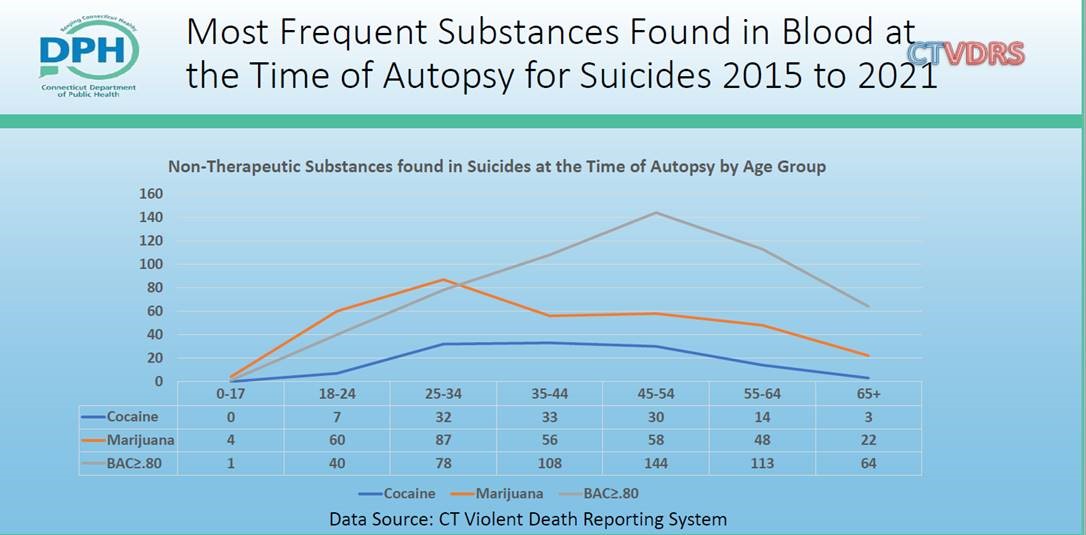Suicide Rates on the Rise Among Underage Cannabis Users
Posted on
A new study has unveiled a frightening fact: across the United States, the number of attempted suicides by cannabis users has been rising by about 17% each year. Looking at a 13-year span (2009 through 2021), researchers also found that cannabis-linked suicide attempts were highest among young people ages 14 to 18.
This national trend is reflected in Connecticut’s data as well. Analyzing 2015-2021 data from the state’s Violent Death Reporting System, the Department of Public Health found cannabis to be among the top three most frequent substances found in blood at the time of autopsy for suicides (as illustrated in the table below). For suicide victims through age 34, it was the #1 substance found.

Since its adult-use legalization in Connecticut last year, access to cannabis among all age groups is expected to rise. Data must be monitored closely going forward to determine whether this increase in access will correlate with an increase in suicide attempts. For now, however, we can work to better understand this concerning trend by shedding light on the factors that contribute to it.
Cannabis & Mental Health: What’s the Link?
About one-third of today’s high school students use cannabis, with many of them believing it to be a safe alternative to harder drugs or a quick way to relax and have fun.
Unfortunately, these beliefs are misguided. While immediate risks—such as engaging in risky behavior, driving under the influence, and health problems—may not be as great, cannabis does have a variety of dangerous side effects. With regular cannabis use, young people have an increased chance of developing anxiety, depression, psychosis, and/or suicidality. Underlying mental health conditions such as bipolar disorder can be exacerbated by cannabis use. And in the long-term, cannabis users are more likely to exhibit anti-social behavior and substance addiction.
In part, this is because cannabis can “re-wire” important regions of the adolescent brain, which continues developing until about age 25. Negative impacts on cognitive functions like impulse control and decision-making are irreversible—and for teens who have been using cannabis to cope with depression, stress, performance anxiety, or other challenges, this can be the start of a negative feedback loop.
Social & Environmental Factors
Of course, this negative feedback loop does not necessarily begin with cannabis use. Young people who use cannabis as a coping method for stress or social isolation, or who feel pressured into cannabis use—whether by their peers or by its normalization within their community—are already in a vulnerable position. In other words, the correlation between underage cannabis use and suicidality does not equate to causation.
However, once a young person is caught in this loop, getting disentangled can be difficult. Hallmark warning signs of Cannabis Use Disorder include losing interest in school and athletics, giving up once-loved hobbies, and turning away from friends and relationships. These are major life changes for most teenagers, and may leave them feeling a sense of alienation or societal stigmatization.
Even for teens who recognize these “red flags,” there can be plenty of obstacles to getting help. They may worry about facing legal repercussions or getting in trouble at home, since non-medical cannabis use is illegal for people under age 21, even in states where adult use has been legalized. Many teens also lack access to mental health services, or simply aren’t aware of the available supports, which further compounds their isolation and path to addiction. Whether mental health issues have been the cause or the effect of a teen’s cannabis use, this struggle can be overwhelming, and the situation may feel hopeless.
The Path Forward
The urgency of this issue is clear. As cannabis becomes increasingly available, we must address the mental health implications for our country’s young people with a multi-pronged approach that includes:
- Encouraging further research
- Developing effective prevention strategies
- Supporting mental health education
- Advocating for destigmatization efforts
Prevention efforts can also start at home. Spreading awareness of the risks—how cannabis can irreversibly alter the course of brain development, the potential for negative effects, and its role in exacerbating underlying mental health conditions—is critical, so starting conversations can have a big impact. Talk with your family, friends, and community at large, sharing what you’ve heard and pausing to listen. The link between cannabis use and mental health is complex, but the more we know, the stronger we can be.
Help is Available
If you or someone you know is in emotional distress or struggling with thoughts of suicide, don’t wait to reach out. Free, confidential help is available 24/7. Dial 988 for the National Suicide Prevention Lifeline, or text ‘TALK’ to the Crisis Text Line at 741741. These services can help you get access to a mental health evaluation and treatment for your child.
Visit the American Foundation for Suicide Prevention website to learn more and to find additional resources.
Resources included at the recommendation of Reporting on Suicide.
